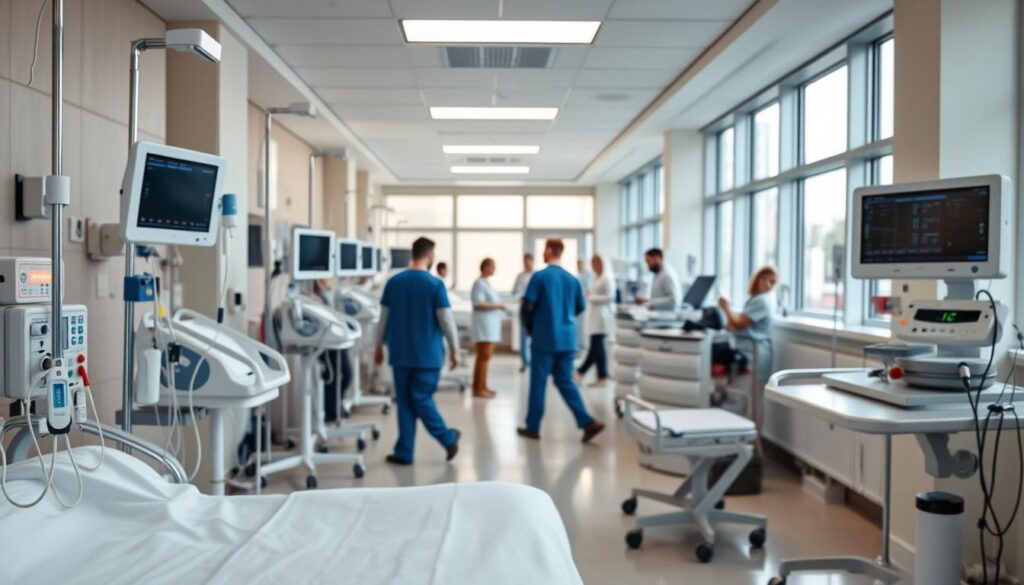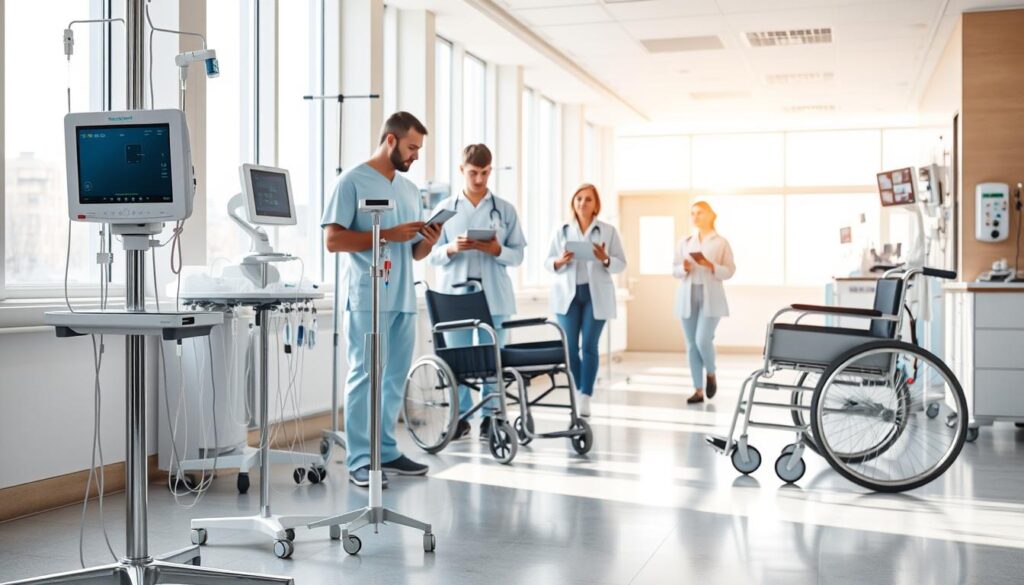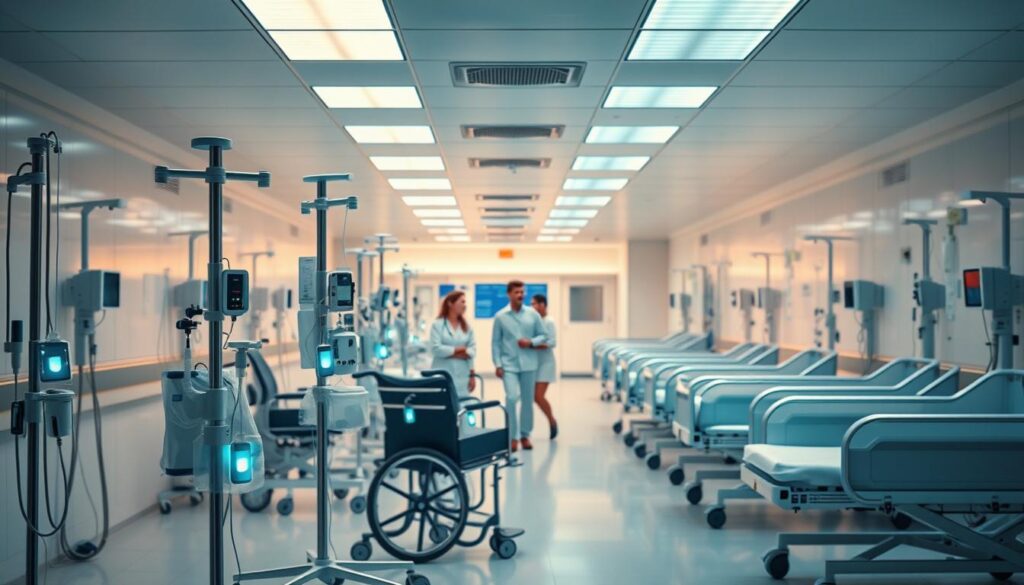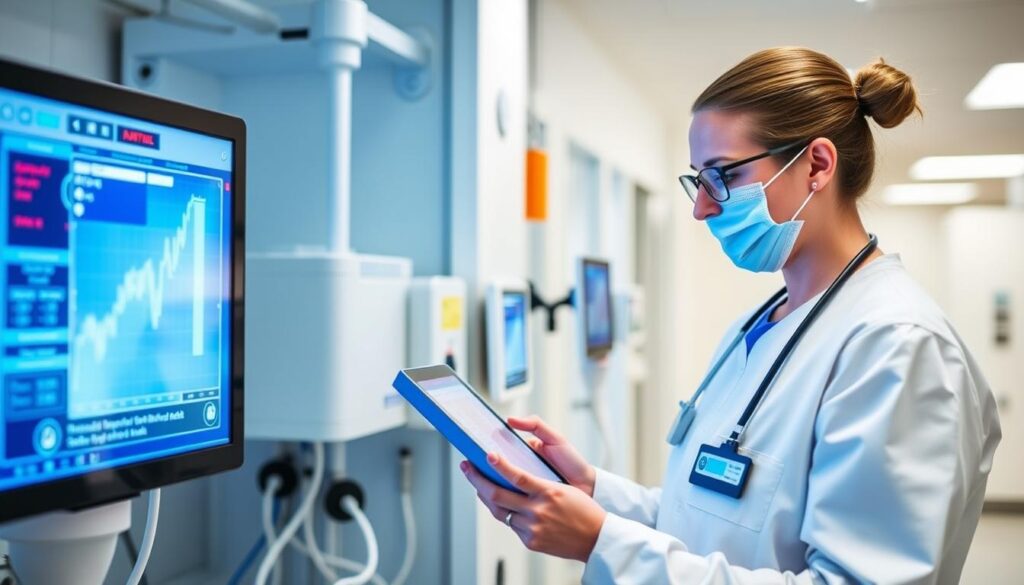The healthcare industry is witnessing a significant transformation with the adoption of advanced technologies like IoT and RFID to improve operational efficiency. One area where this is particularly evident is in hospital asset tracking. Hospitals lose billions annually due to misplaced or underutilized equipment, a problem that can be mitigated with the right tracking systems.
![]()
With the global IoT in healthcare market valued at USD 53.64 billion in 2024 and expected to reach USD 368.06 billion by 2034, the importance of asset tracking systems cannot be overstated. These systems help automate preventive maintenance, track utilization, and provide real-time insights, enabling healthcare providers to deliver better care.
Key Takeaways
- Top hospital asset tracking systems can significantly reduce equipment loss and improve operational efficiency.
- IoT technology is revolutionizing healthcare by enabling real-time tracking and monitoring.
- The right tracking system can help healthcare facilities make informed decisions and improve patient care.
- Leading healthcare providers are adopting advanced asset tracking solutions to stay ahead.
- The global IoT in healthcare market is expected to grow exponentially in the next decade.
The Critical Need for Hospital Asset Tracking in Modern Healthcare
Modern hospitals face significant challenges in managing their vast array of critical assets, from ventilators and surgical equipment to mobile monitors and diagnostic tools, all of which need to be properly maintained and readily available.
The complexity of healthcare environments demands efficient asset tracking systems to ensure that every piece of medical equipment is accounted for, maintained on time, and ready to use without delay or confusion.
Current Challenges in Hospital Asset Management
Many healthcare facilities still rely on outdated tracking methods like spreadsheets or legacy systems that merely record data without driving actionable insights. This leads to equipment hoarding, loss, and inefficient utilization.
- Inadequate tracking methods result in wasted time searching for assets.
- Lack of visibility into asset lifecycles leads to over-maintenance or neglect.
- Inefficient management of equipment increases operational costs.

The Cost of Inefficient Asset Tracking in Healthcare
The financial impact of inefficient asset tracking is substantial, with hospitals experiencing increased capital expenditures due to unnecessary purchases and maintenance inefficiencies.
| Challenge | Impact |
|---|---|
| Inefficient Asset Tracking | Increased Capital Expenditures |
| Equipment Downtime | Directly Affects Patient Care |
| Lack of Visibility | Premature Replacements and Increased Operational Costs |
By understanding these challenges and their financial implications, healthcare facilities can begin to appreciate the critical need for effective hospital asset tracking systems.
Understanding Hospital Asset Tracking Systems
Hospital asset tracking systems are revolutionizing healthcare by providing real-time visibility into equipment location and status. These systems are more than just digital spreadsheets; they are comprehensive platforms that utilize advanced technologies to manage medical equipment throughout a healthcare network.
What is a Healthcare Asset Management Solution?
A healthcare asset management solution is a real-time platform that centralizes inventory, automates maintenance, tracks utilization, drives compliance, and provides analytics for every piece of physical equipment. By leveraging technologies like RFID, QR code tracking, IoT sensors, and Wi-Fi RTLS, these systems ensure that healthcare providers can answer critical questions about asset location, condition, usage history, and maintenance requirements.
These solutions go beyond simple inventory management by providing a unified ecosystem that connects equipment data with maintenance workflows, compliance requirements, and resource allocation decisions. This integration enables proactive management of assets, transforming passive tracking into a strategic advantage for healthcare facilities.
Key Technologies Powering Modern Hospital Asset Tracking
Modern hospital asset tracking systems employ a range of technologies to maintain continuous visibility of equipment. These include RFID tags, QR codes, IoT sensors, Bluetooth Low Energy (BLE) beacons, and Wi-Fi Real-Time Location Systems (RTLS). By combining these technologies, hospitals can achieve a comprehensive understanding of their asset utilization and optimize their management strategies.

The integration of these technologies enables healthcare facilities to streamline their operations, reduce costs, and improve patient care. As the healthcare industry continues to evolve, the role of advanced asset tracking systems will become increasingly critical in ensuring the efficient management of medical equipment and devices.
Core Features of Effective Hospital Asset Tracking Systems
The backbone of any successful hospital asset management strategy is a robust tracking system with advanced features. Effective hospital asset tracking systems are designed to streamline operations, reduce costs, and improve patient care by ensuring that critical equipment is always available when needed.
Real-Time Location Tracking Capabilities
A key feature of modern asset tracking systems is their ability to provide real-time location tracking. Using technologies such as RFID, BLE, or Wi-Fi triangulation, these systems can pinpoint the exact location of equipment across departments, floors, or even buildings. “With real-time tracking, hospitals can eliminate the guesswork in locating equipment, saving time and reducing operational inefficiencies,” says an industry expert. Custom geofencing capabilities further enhance this feature by alerting staff if high-value equipment leaves designated areas.

Preventive Maintenance Scheduling
Another crucial feature is preventive maintenance scheduling. Advanced systems automatically flag assets due for inspection based on actual usage patterns, supporting Alternate Equipment Maintenance (AEM) programs. This ensures that maintenance is performed when necessary, rather than on a fixed schedule, thereby optimizing equipment performance and extending its lifespan.
Compliance and Documentation Management
Compliance and documentation management are also vital components. These systems maintain comprehensive digital records of all maintenance activities, inspection reports, and certifications, making it easier for hospitals to prepare for audits and demonstrate compliance with regulatory requirements.
By incorporating these core features, effective hospital asset tracking systems not only improve operational efficiency but also enhance patient care by ensuring that critical equipment is properly maintained and readily available.
Benefits of Implementing IoT-Powered Hospital Asset Tracking
By leveraging IoT-powered hospital asset tracking, healthcare facilities can achieve enhanced operational efficiency and patient care. The integration of IoT technology in hospital asset management isn’t just about knowing where assets are—it’s about unlocking performance across care, cost, and compliance.

Operational Efficiency and Workflow Improvements
Implementing IoT-powered hospital asset tracking systems leads to significant operational efficiency improvements. By eliminating time-consuming equipment searches, streamlining workflows, and reducing delays in patient care procedures, hospitals can optimize their resources. This results in shorter delays and smoother workflows, allowing medical staff to locate, clean, and prepare devices instantly, thus improving bed turnover and ensuring procedures run on time.
Cost Reduction and Resource Optimization
The financial benefits of IoT-powered hospital asset tracking are substantial. Tagging systems can cut equipment loss by up to 20%, while utilization data enables more informed decisions about asset allocation, potentially reducing rental spend by 15-30%. Additionally, condition monitoring and preventive schedules can stop equipment failures before they happen, leading to 20-25% fewer critical equipment issues and 90% less time spent locating gear.
Enhanced Patient Care and Safety
Enhanced patient care and safety are direct results of ensuring the right equipment is available at the right time. This reduces procedure delays and improves overall healthcare delivery outcomes. The integration of AI capabilities with IoT tracking creates predictive systems that can anticipate equipment needs, prevent failures before they occur, and optimize resource distribution based on historical usage patterns, ultimately leading to better patient care and safety.
Top 5 Hospital Asset Tracking Systems in 2025
With the projected CAGR of over 15% through 2030, the hospital asset tracking market is poised to revolutionize the way healthcare facilities manage their assets. As healthcare systems prioritize efficiency and compliance, the demand for advanced asset tracking solutions has never been higher.

Selection Criteria and Evaluation Methodology
Our evaluation of the top hospital asset tracking systems for 2025 is based on comprehensive criteria, including technological capabilities, integration potential with electronic health records, scalability, user experience, and total cost of ownership.
- Technological capabilities, such as real-time location tracking and preventive maintenance scheduling
- Integration potential with existing hospital infrastructure, including electronic health records and clinical information systems
- Scalability and flexibility to adapt to changing healthcare needs
- User experience and training requirements
- Total cost of ownership, including implementation, maintenance, and support costs
| Evaluation Criteria | Description | Weightage |
|---|---|---|
| Technological Capabilities | Real-time location tracking, preventive maintenance scheduling, and actionable analytics | 30% |
| Integration Potential | Integration with electronic health records and clinical information systems | 25% |
| Scalability and Flexibility | Ability to adapt to changing healthcare needs and growing demands | 20% |
| User Experience | Ease of use, training requirements, and user satisfaction | 15% |
| Total Cost of Ownership | Implementation, maintenance, and support costs | 10% |
The evaluation methodology incorporated feedback from healthcare facilities currently using these systems, focusing on measurable improvements in asset utilization, maintenance efficiency, and overall return on investment.
1. CenTrak RTLS Asset Management Solution

In the realm of healthcare asset management, CenTrak’s RTLS solution stands out for its precision and reliability. CenTrak specializes in real-time location services (RTLS) for the healthcare industry, helping track critical assets like wheelchairs and equipment.
Key Features and Capabilities
CenTrak’s RTLS Asset Management Solution offers highly accurate room-level location tracking capabilities, utilizing a combination of infrared, RFID, Bluetooth Low Energy, and Wi-Fi technologies. The system provides comprehensive asset visibility with customizable dashboards that display real-time location, status, and utilization metrics for all tagged hospital equipment.
The solution integrates seamlessly with existing hospital systems, including electronic health records and maintenance management platforms, creating a unified ecosystem for asset management.
Strengths and Limitations
The CenTrak solution excels in accuracy and reliability, with strengths including its scalability for multi-building healthcare networks and robust reporting capabilities. It has a proven track record of reducing equipment loss and rental costs. However, some healthcare facilities report that the initial implementation requires significant infrastructure investment, particularly for larger hospital campuses. Additionally, the advanced features come with a steeper learning curve for staff.
2. GE Healthcare AssetPlus
![]()
GE Healthcare’s AssetPlus is revolutionizing hospital asset management with its cutting-edge technology. This comprehensive IoT-powered hospital asset tracking system is designed to optimize asset utilization, reduce costs, and improve patient care.
Key Features and Capabilities
GE Healthcare’s AssetPlus offers a robust asset management solution that extends beyond simple tracking to include predictive maintenance, lifecycle management, and detailed utilization analytics for medical equipment. The system leverages GE’s extensive healthcare expertise to provide industry-specific workflows and equipment management protocols that align with regulatory requirements and best practices.
Some of the key features of AssetPlus include:
- Robust integration capabilities with GE’s own medical devices and third-party equipment, creating a unified view of all hospital assets regardless of manufacturer.
- Advanced predictive maintenance algorithms that analyze equipment usage patterns and performance metrics to anticipate potential failures before they impact patient care.
Strengths and Limitations
A key strength of AssetPlus is its ability to provide advanced analytics and insights that help healthcare providers optimize their asset utilization. However, some healthcare providers report that the system works best within GE-centric environments and may require additional configuration for facilities with diverse equipment inventories.
Despite this limitation, AssetPlus remains a powerful tool for hospitals looking to optimize their asset tracking and management. Its comprehensive features and capabilities make it a top contender in the hospital asset tracking market.
3. ASCOM Healthcare Communication Platform
![]()
The ASCOM Healthcare Communication Platform is revolutionizing hospital asset tracking by integrating it with a broader communication ecosystem. This innovative solution connects equipment management with clinical workflows and staff coordination, enhancing the overall efficiency of hospital operations.
Key Features and Capabilities
The ASCOM Healthcare Communication Platform distinguishes itself by integrating asset tracking capabilities within a broader communication ecosystem. This integration enables real-time alerts about equipment status to be delivered directly to the appropriate healthcare providers, streamlining clinical workflows.
The system’s advanced workflow automation triggers specific communication protocols based on asset location, status changes, or maintenance requirements. This feature ensures that hospital staff are always informed and up-to-date on asset availability and status.
Strengths and Limitations
A significant strength of the ASCOM solution is its unified approach to hospital operations, creating seamless connections between people, processes, and equipment to enhance overall patient care delivery. However, some users note that the dedicated asset tracking capabilities may not be as comprehensive as systems focused exclusively on equipment management.
Despite this limitation, the ASCOM Healthcare Communication Platform remains a robust solution for hospitals seeking to integrate asset tracking with clinical communication and workflow management.
4. Honeywell RTLS Asset Tracking System

With its advanced RTLS technology, Honeywell provides a top-tier asset tracking solution tailored to the healthcare industry’s unique needs. Honeywell’s RTLS Asset Tracking System leverages the company’s industrial expertise to deliver a robust, enterprise-grade solution specifically adapted for the unique challenges of healthcare environments.
Key Features and Capabilities
The Honeywell RTLS Asset Tracking System boasts several key features that make it an ideal choice for hospital asset management. These include:
- Military-grade security protocols to ensure data protection and compliance with stringent healthcare information security requirements.
- Exceptional durability and reliability in high-traffic hospital environments, with ruggedized tags designed to withstand frequent disinfection procedures.
- A sophisticated analytics engine that transforms tracking data into actionable insights about equipment utilization patterns, bottlenecks, and optimization opportunities.
Strengths and Limitations
While the Honeywell RTLS Asset Tracking System excels in security and durability, some healthcare facilities report that the implementation process can be more complex compared to healthcare-native solutions. This may require additional configuration to align with clinical workflows. Nonetheless, the system’s features and capabilities make it a valuable investment for hospitals seeking to optimize their asset utilization and improve overall efficiency.
5. Midmark RTLS Asset Management

Midmark’s clinically-focused RTLS Asset Management system is designed to enhance patient care by optimizing the use of medical equipment across various hospital departments. This system is particularly beneficial for high-volume areas such as emergency departments and operating rooms.
Key Features and Capabilities
Midmark RTLS Asset Management offers a range of features that cater to the specific needs of healthcare facilities. These include:
- Specialized solutions for different hospital environments, each with customized tracking protocols.
- Purpose-built hardware components, such as unobtrusive tags and sensors, designed to maintain the healing environment.
- An intuitive user interface that requires minimal training, facilitating rapid adoption across staff roles.
Strengths and Limitations
A notable strength of Midmark RTLS Asset Management is its ability to integrate with clinical workflows, enhancing operational efficiency. However, some healthcare facilities have reported that the system’s enterprise-wide analytics capabilities may not be as comprehensive as those offered by larger technology vendors.
Despite this limitation, Midmark RTLS Asset Management remains a robust solution for hospitals seeking to improve asset utilization and streamline their operations.
Implementation Considerations for Hospital Asset Tracking
As hospitals look to implement asset tracking, they must navigate a complex landscape of infrastructure and operational needs. Successful implementation requires a comprehensive understanding of the challenges and considerations involved.
Infrastructure and Deployment
The infrastructure requirements for hospital asset tracking systems are multifaceted. A thorough assessment of existing infrastructure is necessary, including wireless network coverage, power availability, and physical space for sensors and gateways throughout the facility. Signal interference is also a significant concern, as concrete walls, medical equipment, and complex building layouts can impact tracking accuracy and reliability.
- Assess existing infrastructure, including wireless network coverage and power availability.
- Consider signal interference and its potential impact on tracking accuracy.
Staff Training and Change Management
A comprehensive staff training program is essential for system adoption, ensuring that all users understand how to interact with the tracking technology and incorporate it into their daily workflows. Change management strategies should address potential resistance by clearly communicating the benefits of asset tracking for different stakeholder groups.
- Develop a comprehensive staff training program to ensure successful system adoption.
- Implement change management strategies to address potential resistance.
Future Trends in Hospital Asset Tracking Technology
The hospital asset tracking landscape is evolving rapidly with new technologies. As healthcare facilities continue to adopt innovative solutions, the integration of advanced technologies is set to revolutionize asset management. Future systems will not only track equipment but also anticipate needs, enhancing patient care and operational efficiency.
AI and Predictive Analytics Integration
Artificial Intelligence (AI) is poised to play a crucial role in the future of hospital asset tracking. By analyzing usage patterns and identifying equipment at risk of failure, AI-powered predictive maintenance will become increasingly prevalent. This proactive approach enables healthcare facilities to optimize asset utilization, reduce downtime, and improve overall healthcare delivery.
Blockchain for Enhanced Security and Compliance
Blockchain technology is emerging as a solution for enhanced security and compliance in asset tracking. By creating immutable records of equipment maintenance, usage, and chain of custody, blockchain can satisfy regulatory requirements and provide tamper-proof audit trails for high-value medical equipment. This not only addresses concerns about data integrity but also supports more transparent compliance reporting.
Conclusion: Selecting the Right Hospital Asset Tracking System for Your Facility
In the quest to enhance patient care and operational efficiency, hospitals must prioritize the adoption of a robust asset tracking system. Selecting the right hospital asset tracking system requires careful evaluation of your facility’s specific needs and long-term strategic goals.
The ideal system balances comprehensive tracking capabilities with user-friendly interfaces, encouraging adoption across all departments. Consider both initial implementation costs and long-term return on investment through improved equipment utilization and reduced loss.
For more information on optimizing your hospital’s asset management, contact us at www.iottive.com or sales@iottive.com.
FAQ
What is the primary purpose of implementing a medical equipment tracking system in healthcare facilities?
The primary purpose is to improve operational efficiency by ensuring that medical equipment is readily available when needed, reducing downtime, and streamlining maintenance schedules.
How do RFID and other technologies enhance asset management in healthcare?
RFID and other technologies enable real-time location tracking, automated inventory management, and more accurate data collection, leading to better decision-making and reduced costs.
What are the key benefits of using an electronic health record (EHR) system in conjunction with an asset tracking system?
Integrating EHRs with asset tracking systems allows for more accurate and efficient patient care, improved data security, and enhanced compliance with regulatory requirements.
How can healthcare providers ensure data security when implementing an asset tracking system?
Healthcare providers can ensure data security by selecting systems with robust security measures, such as encryption, access controls, and regular software updates, to protect sensitive information.
What role does predictive analytics play in modern asset management?
Predictive analytics helps healthcare organizations anticipate equipment failures, optimize maintenance schedules, and reduce downtime, ultimately improving patient care and reducing costs.
How can healthcare facilities measure the ROI of implementing an asset tracking system?
Healthcare facilities can measure ROI by tracking key performance indicators (KPIs) such as reduced equipment losses, improved equipment utilization, and decreased maintenance costs.
What are the common challenges associated with implementing an asset tracking system?
Common challenges include infrastructure requirements, staff training, and change management, as well as ensuring compliance with regulatory requirements and addressing potential data security concerns.
Transform Your IoT Vision Into Reality.
Get free expert insights, architectures & cost breakdowns.
Drop you email to schedule free meeting.